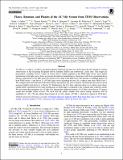Flares, Rotation, and Planets of the AU Mic System from TESS Observations
Author(s)
Gilbert, Emily A; Barclay, Thomas; Quintana, Elisa V; Walkowicz, Lucianne M; Vega, Laura D; Schlieder, Joshua E; Monsue, Teresa; Cale, Bryson L; Collins, Kevin I; Gaidos, Eric; El Mufti, Mohammed; Reefe, Michael A; Plavchan, Peter; Tanner, Angelle; Wittenmyer, Robert A; Wittrock, Justin M; Jenkins, Jon M; Latham, David W; Ricker, George R; Rose, Mark E; Seager, S; Vanderspek, Roland K; Winn, Joshua N; ... Show more Show less
DownloadPublished version (2.187Mb)
Publisher with Creative Commons License
Publisher with Creative Commons License
Creative Commons Attribution
Terms of use
Metadata
Show full item recordAbstract
<jats:title>Abstract</jats:title>
<jats:p>AU Mic is a young (∼24 Myr), pre-main-sequence M dwarf star that was observed in the first month of science observations of the Transiting Exoplanet Survey Satellite (TESS) and reobserved 2 years later. This target has photometric variability from a variety of sources that is readily apparent in the TESS light curves; spots induce modulation in the light curve, flares are present throughout (manifesting as sharp rises with slow exponential decay phases), and transits of AU Mic b may be seen by eye as dips in the light curve. We present a combined analysis of both TESS Sector 1 and Sector 27 AU Mic light curves including the new 20 s cadence data from TESS Year 3. We compare flare rates between both observations and analyze the spot evolution, showing that the activity levels increase slightly from Sector 1 to Sector 27. Furthermore, the 20 s data collection allows us to detect more flares, smaller flares, and better resolve flare morphology in white light as compared to the 2 minute data collection mode. We also refine the parameters for AU Mic b by fitting three additional transits of AU Mic b from Sector 27 using a model that includes stellar activity. We show that the transits exhibit clear transit timing variations with an amplitude of ∼80 s. We also detect three transits of a 2.8 <jats:italic>R</jats:italic>
<jats:sub>⊕</jats:sub> planet, AU Mic c, which has a period of 18.86 days.</jats:p>
Date issued
2022Department
Massachusetts Institute of Technology. Department of Earth, Atmospheric, and Planetary SciencesJournal
Astronomical Journal
Publisher
American Astronomical Society
Citation
Gilbert, Emily A, Barclay, Thomas, Quintana, Elisa V, Walkowicz, Lucianne M, Vega, Laura D et al. 2022. "Flares, Rotation, and Planets of the AU Mic System from TESS Observations." Astronomical Journal, 163 (4).
Version: Final published version